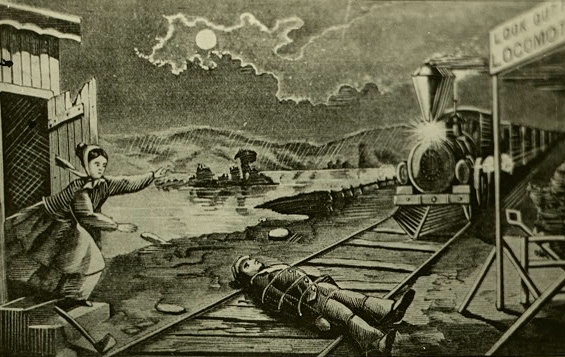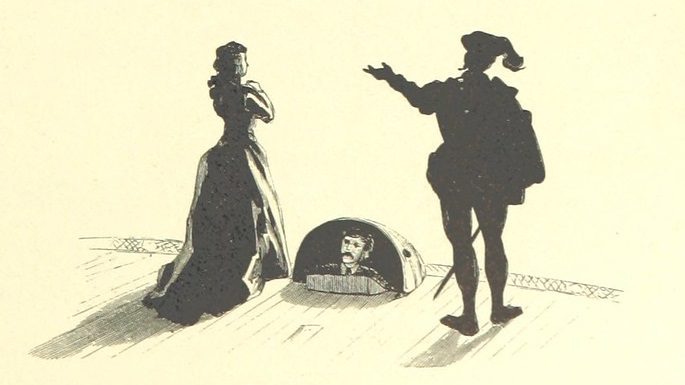A Faculty Feature by Dr. Emily Tucker
Popular theater in nineteenth-century Britain drew enormous audiences and exerted tremendous influence on writers in other genres. Sadly, though, it has a bad reputation as “the nadir of the English drama.”1 Other than late-century playwrights like Oscar Wilde and George Bernard Shaw, most writers for the nineteenth-century stage are rarely taught in college courses or performed in theaters anymore.
Okay, I’ll admit, there is plenty to dislike, from contrived plotting to political messages that could veer into sexism, racism, colonialism, and other problems. Still, if you’re willing to wade through some occasionally terrible texts, there are moments of tremendous creativity and humor. As a preview of my upcoming public talk at the English Department Colloquium on Dec. 3rd, I’ve collected a few of those gems for you here:
Surprising Feminist Origins of the Train Tracks Rescue
The thrilling, last-minute rescue of a damsel in distress tied to railroad tracks is popularly (somewhat erroneously) thought of as a cliché of the silent film era, but it appeared far more frequently on stage. While these days, the trope is often associated with female victims rescued by men, this wasn’t always the case.
The train tracks rescue was popularized by Augustin Daly’s 1867 play Under the Gaslight, an American play that eventually made its way to London. It inspired many other plays to make use of the dangers of the railway—in fact, Daly won a court case against the famous Irish playwright Dion Boucicault after Boucicault included a similar scene in his 1868 play After Dark.2
Under the Gaslight features a male victim named Snorkey who is tied to the tracks while the heroine, Laura, is locked in a nearby shed. She breaks down the door with an axe and releases Snorkey just before the express train rushes past. The scene ends with the grateful Snorkey exclaiming: “And these are the women who ain’t to have a vote!”

Expressive Forms of Being Angry for a Polite Audience
Creative insults and emotional outbursts are certainly not unique to the nineteenth-century stage, but the oversized emotions combined with the sometimes rigid licensing standards of the Lord Chamberlain’s Office led to some particularly interesting examples.
Nineteenth-century audiences were treated to invectives like “rascally night hawk!” and “herring-gutted villain!” Meanwhile, villains who found their evil plans flummoxed would sometimes give audiences a condensed version of their own psychological state; for instance, an American play adapted for the British stage features a frustrated evildoer shouting “Confusion!”
Stage Adaptations That Preceded the Completion of their Source Materials
Because many Victorian novels were serialized, there could be a substantial gap in time between the publication of the initial chapters and the final ones. Playwrights attempting to capitalize on popular novels still ongoing were therefore frequently in the position of having to write their own endings. Scholar Deborah Vlock notes that there were twenty-five theatrical versions of Dickens’s Nicholas Nickleby produced before the novel’s completion, resulting in what she terms “a larger Nickleby experience.”3
The circulation of numerous versions of the plot and characters while the novel was still in process gave nineteenth-century audiences a sort of precursor to today’s popular culture, in which book series, film and television adaptations, and fan-created works all contribute to our perceptions of popular stories and characters.
Lots of Plays on Words
Comedic theatrical fare was very reliant on puns and wordplay, like this moment from J. R. Planche’s The Golden Fleece:
Chorus: Sir, I’m the chorus.
King: Sir, you’re indecorous.
Henry J. Byron’s Esmeralda, or the “Sensation” Goat!, a cheerier version of The Hunchback of Notre Dame, features many similar moments of comedic wordplay, such as:
A poet, forced from the bay-leaf to fly,
‘Tis altogether past belief
The play also links “homicide” to “oh, my side!” and “animate it all” to “any mate at all.”
Humorous Versions of Shakespeare
Nineteenth-century audiences often found a lot of humor in Shakespeare’s plays, and not just in his comedies. Shakespearean scholar Daniel Pollack-Pelzner argues that comedic versions of Shakespearean plays in the nineteenth century formed an “alternate literary history” that allowed for interpretations of Shakespeare outside of the emphasis on interiority.4
Referred to as travesties or burlesques, many Victorian versions of Shakespeare were designed to entertain audiences by contrasting the elevated language with silliness, such as by having Romeo and Juliet’s balcony scene marred by a case of the sniffles. This same 1859 version, by Andrew Halliday, also features Queen Mab turning up at the end to bring all of the characters back to life so that they can yell at Shakespeare’s ghost!
Perdita, or The Royal Milkmaid, loosely based on The Winter’s Tale, resolves Shakespeare’s famous stage direction for Antigonus to “exit pursued by a bear” more happily than Shakespeare’s play does: instead of being mauled to death off-stage, Antigonus turns up at the play’s end with a large furry friend, who’s now wearing respectable clothing and has learned how to dance. Sadly, this reimagining of the bear’s role failed to make a lasting impact—every production I’ve seen of Shakespeare’s text has left Antigonus to his originally-planned misfortunes.

These plays are rarely or never performed for contemporary audiences, often for entirely legitimate reasons. However, the existing scripts give us a fascinating glimpse into popular entertainment at this point in time, and contain many moments of humor and drama that are worthy of applause.
Professor Tucker will speak on “Charles Dickens & Victorian Melodrama” at the English Colloquium on Tuesday, December 3rd at 5:30 p.m. in VanderWerf 104. Professor McGunigal is also presenting. Pizza provided. All of Hope is invited.
References:
- Hadley, Elaine. Melodramatic Tactics: Theatricalized Dissent in the English Marketplace, 1800-1855, (Stanford UP, 1995), 2. ↩
- Daly, Nicholas. “Blood on the Tracks: Sensation Drama, the Railway, and the Dark Face of Modernity,” (Victorian Studies, vol. 42, no. 1, 1998), 48-49. ↩
- Vlock, Deborah. Dickens, Novel Reading, and the Victorian Popular Theatre, (Cambridge UP, 1998), 3. ↩
- Pollack-Pelzner, Daniel. “Shakespeare Burlesque and the Performing Self,” (Victorian Studies, vol. 54, no. 3, 2012), 401. ↩


